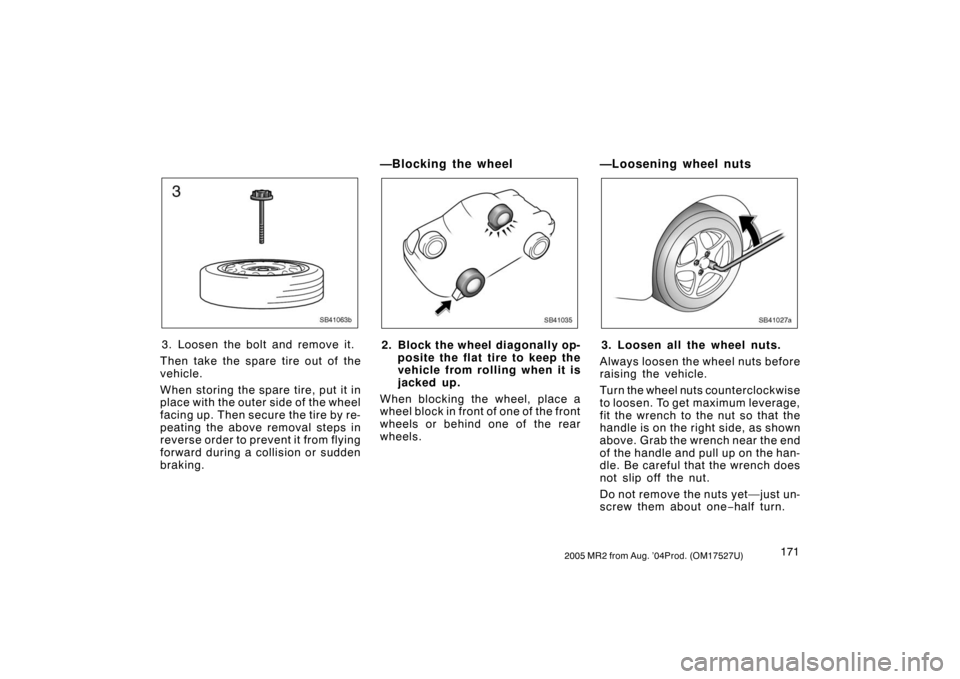Page 176 of 259

1682005 MR2 from Aug. ’04Prod. (OM17527U)
CAUTION
When jacking, be sure to observe
the following to reduce the possi-
bility of personal injury:
�Follow jacking instructions.
�Do not put any part of your
body under the vehicle sup-
ported by the jack. Personal in-
j u ry may occu r.
�Do not start or run the engine
while your vehicle is supported
by the jack.
�Stop the vehicle on a level firm
ground, firmly set the parking
brake and put the transmission
in “R” (sequential manual
transmission) or in reverse
(manual transmission). Block
the wheel diagonally opposite
to the one being changed if
necessary.
�Make sure to set the jack prop-
erly in the jack point. Raising
the vehicle with jack improper-
ly positioned will damage the
vehicle or may allow the ve-
hicle to fall off the jack and
cause personal injury.
�Never get under the vehicle
when the vehicle is supported
by the jack alone.
�Use the jack only for lifting
your vehicle during wheel
changing.
�Do not raise the vehicle with
someone in the vehicle.
�When raising the vehicle, do
not put an object on or under
the jack.
�Raise the vehicle only high
enough to remove and change
the tire.NOTICE
Do not continue driving with a
deflated tire. Driving even a
short distance can damage a
tire and wheel beyond repair.
Page 179 of 259

1712005 MR2 from Aug. ’04Prod. (OM17527U)
SB41063b
3. Loosen the bolt and remove it.
Then take the spare tire out of the
vehicle.
When storing the spare tire, put it in
place with the outer side of the wheel
facing up. Then secure the tire by re-
peating the above removal steps in
reverse order to prevent it from flying
forward during a collision or sudden
braking.
—Blocking the wheel
SB41035
2. Block the wheel diagonally op-
posite the flat tire to keep the
vehicle from rolling when it is
jacked up.
When blocking the wheel, place a
wheel block in front of one of the front
wheels or behind one of the rear
wheels.
—Loosening wheel nuts
SB41027a
3. Loosen all the wheel nuts.
Always loosen the wheel nuts before
raising the vehicle.
Turn the wheel nuts counterclockwise
to loosen. To get maximum leverage,
fit the wrench to the nut so that the
handle is on the right side, as shown
above. Grab the wrench near the end
of the handle and pull up on the han-
dle. Be careful that the wrench does
not slip off the nut.
Do not remove the nuts yet—just un-
screw them about one−half turn.
Page 180 of 259
1722005 MR2 from Aug. ’04Prod. (OM17527U)
CAUTION
Never use oil or grease on the
bolts or nuts. The nuts may loos-
en and the wheels may fall off,
which could cause a serious ac-
cident.
—Positioning the jack
SB41036
4. Position the jack at the correct
jack point as shown.
Make sure the jack is positioned on
a level and solid place.
—Raising your vehicle
SB41029
5. After making sure that no one
is in the vehicle, raise it high
enough so that the compact
spare tire can be installed.
Remember you will need more ground
clearance when putting on the com-
pact spare tire than when removing
the flat tire.
To raise the vehicle, insert the jack
handle into the jack (it is a loose fit)
and turn it clockwise. As the jack
touches the vehicle and begins to lift,
double−check that it is properly posi-
tioned.
Page 181 of 259
1732005 MR2 from Aug. ’04Prod. (OM17527U)
CAUTION
Never get under the vehicle when
the vehicle is supported by the
jack alone.
—Changing wheels
SB41028a
6. Remove the wheel nuts and
change tires.
Lift the flat tire straight off and put it
aside.
Roll the spare wheel into position and
align the holes in the wheel with the
bolts. Then lift up the wheel and get
at least the top bolt started through
its hole. Wiggle the tire and press it
back over the other bolts.
SB41044b
Before putting wheels on, remove any
corrosion on the mounting surfaces
with a wire brush or such. Installation
of wheels without good metal−to−met-
al contact at the mounting surface can
cause wheel nuts to loosen and even-
tually cause a wheel to come off while
driving.
Page 183 of 259

1752005 MR2 from Aug. ’04Prod. (OM17527U)
CAUTION
�When lowering the vehicle,
make sure all portions of your
body and all other persons
around will not be injured as
the vehicle is lowered to the
ground.
�Have the wheel nuts tightened
with torque wrench to 103 N·m
(10.5 kgf·m, 76 ft·lbf), as soon
as possible after changing
wheels. Otherwise, the nuts
may loosen and the wheels
may fall off, which could cause
a serious accident.
—After changing wheels
9. Check the air pressure of the re-
placed tire.
Adjust the air pressure to the specifi-
cation designated on page 244 in
Section 8. If the pressure is lower,
drive slowly to the nearest service
station and fill to the correct pressure.
Do not forget to reinstall the tire valve
cap as dirt and moisture could get into
the valve core and possibly cause air
leakage. If the cap is missing, have
a new one put on as soon as possible.
10.Restow all the tools, jack and
flat tire securely.
As soon as possible after changing
wheels, tighten the wheel nuts to the
torque specified on page 244 in Sec-
tion 8 with a torque wrench. Have a
technician repair the flat tire and re-
place the spare tire with it.CAUTION
Before driving, make sure all the
tools, jack and flat tire are se-
curely in place in their storage
location to reduce the possibility
of personal injury during a colli-
sion or sudden braking.
Page 184 of 259
1762005 MR2 from Aug. ’04Prod. (OM17527U)
SB41025
Remove the wheel ornament from the
flat tire before restowing the flat tire.
SB41037
NOTICE
The size of the front wheel and
the rear wheel is different. In
order to prevent the wrong
installation, there is a pin on
the assembly surface inside the
rear wheel as shown above.
Therefore, the rear wheels can-
not be installed on the front.
If your vehicle becomes stuck in snow,
mud, sand, etc., then you may attempt
to rock the vehicle free by moving it
forward and backward.
CAUTION
Do not attempt to rock the vehicle
free by moving it forward and back-
ward if people or objects are any-
where near the vehicle. During the
rocking operation the vehicle may
suddenly move forward or backward
as it becomes unstuck, causing injury
or damage to nearby people or ob-
jects.
If your vehicle becomes stuck
Page 189 of 259
1812005 MR2 from Aug. ’04Prod. (OM17527U)
SB41066
2. Use the towing eyelet in the tool bag.
Secure it to the hole on the bumper by
turning clockwise. (For the tool bag
storage location, see “—Required tools
and spare tire” on page 169 in this
Section.)
SB41067
3. Tighten the towing eyelet securely by
a wheel nut wrench.
CAUTION
When installing the eyelet on the ve-
hicle, be sure to tighten the eyelet
securely. If the eyelet is loose, it may
come off when being towed and re-
sult in death or serious injury.
SD04002
In case the selector lever lock is not
released and the selector lever cannot
be moved even though the ignition
switch is turned to the ”ON” position,
follow the procedures below:
1. Turn the ignition key to the ”LOCK”
or “ACC” position. Make sure the
parking brake is applied.
2. Pry up the cover with a flat�bladed
screwdriver or equivalent.
If you cannot shift the
sequential manual
transmission selector lever
Page 203 of 259

1952005 MR2 from Aug. ’04Prod. (OM17527U)
Be on the alert for changes in perfor-
mance, sounds, and visual tip−offs that
indicate service is needed. Some impor-
tant clues are as follows:
�Engine missing, stumbling, or pinging
�Appreciable loss of power
�Strange engine noises
�A leak under the vehicle (however, wa-
ter dripping from the air conditioning
after use is normal.)
�Change in exhaust sound (This may
indicate a dangerous carbon monoxide
leak. Drive with the windows open and
have the exhaust system checked im-
mediately.)
�Flat−looking tire; excessive tire squeal
when cornering; uneven tire wear
�Vehicle pulls to one side when driving
straight on a level road
�Strange noises related to suspension
movement
�Loss of brake effectiveness; spongy
feeling brake or clutch pedal; pedal al-
most touches floor; vehicle pulls to one
side when braking
�Engine coolant temperature continually
higher than normalIf you notice any of these clues, take your
vehicle to your Toyota dealer as soon as
possible. It probably needs adjustment or
repair.
CAUTION
Do not continue driving with the ve-
hicle unchecked. It could result in se-
rious vehicle damage and possibly
personal injury.
Some states have vehicle emission in-
spection programs which include OBD
(On−Board Diagnostics) checks.
The OBD system monitors the operation
of the emission control system. When the
OBD system determines that a problem
exists somewhere in the emission control
system, the malfunction indicator lamp
comes on. In this case, your vehicle may
not pass the I/M test and need to be
repaired. Contact your Toyota dealer to
service the vehicle.
Even if the malfunction indicator lamp
does not come on, your vehicle may not
pass the I/M test as readiness codes
have not been set in the OBD system.
Readiness codes are automatically set
during ordinary driving. However, when the
battery is disconnected or run down, the
codes are erased. Also, depending on
your driving habits, the codes may not be
completely set.
Also, if the malfunction indicator lamp had
come on recently due to temporary mal-
function such as a loose fuel tank cap,
your vehicle may not pass the I/M test.
Does your vehicle need
repairing?Emissions Inspection and
Maintenance (I/M) programs